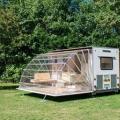GDZ ready-made homework workbook and contour maps for geography Grade 7 Korinskaya, Dushina FSES from Putin. The answer book (answers to questions and tasks) of textbooks and workbooks is necessary to check the correctness of homework without downloading online
1. What and for what purpose is studied in the course of geography of continents and oceans.
1. Read the table of contents of the textbook and fill in the table.
2. Consider what is the basis of the following checklist:
Eurasia, Africa, America, Australia, Antarctica.
The proposed list is based on the names of the parts of the world.
3. Name the continents:
A) The largest is Eurasia
B) The most populated - Eurasia
B) With the most indented coastline - North America
D) With the largest number of countries - Eurasia.
4. The figure shows data on the ratio of land and ocean areas in the Northern and Southern Hemispheres and throughout the Earth. Determine which ones belong to which hemisphere.
A. All over the Earth
B. Northern Hemisphere
B. Southern Hemisphere
5. The surface of the Earth is conventionally divided into the Northern, Southern, Eastern and Western hemispheres, as well as the continental and oceanic hemispheres. Which hemispheres are shown in the figure?
Mainland and oceanic hemispheres of the Earth.
6. Why do you think geography is called one of the oldest and youngest earth sciences?
The oldest, because it was born at the dawn of the development of human civilization, and eternally young, since the face of the Earth is always changing, for example, even due to the movement of tectonic plates or human activities, and the achievements of 6 science, which is constantly evolving, help to draw new knowledge about it ...
7. Evaluate the importance of geographical knowledge in a person's daily life. Give examples.
Geographical knowledge helps people, for example, to navigate the terrain, not to get lost in the forest, to choose a place to stay.
2. How people discovered and studied the Earth.
1. Determine from the text of the textbook what basic information about our planet was received by people during each of the stages of finding knowledge about the Earth. Fill the table.
2. Select from the text of the textbook the main reasons that led to the expansion of human knowledge about the Earth.
The desire to learn the laws of nature, to learn how to control the natural processes of the Earth.
3. When were the most significant geographical discoveries made? Why?
In the era of the great geographical discoveries... This is due to the discovery of America, the sea route to India around Africa, Magellan's round-the-world voyage, which proved that the Earth has the shape of a ball.
4. How much travel around the world depicted on the map in the textbook? What are the names of the sailors who made them.
1 - I.F. Kruzenshtein and Yu.F. Lisyansky.
5. What caused the need for the first voyages in the waters of the Arctic Ocean?
Development of new lands, search for new sea routes, fishing and trade of marine animals.
6. Study the text of the textbook on the modern era of the development of knowledge about the Earth, indicate its features.
Before the modern era, there was (and is) the accumulation of knowledge about the Earth, with the help of which modern scientists put forward hypotheses about nature, reveal certain patterns. It became possible to study our planet from space.
7. What are the names of travelers and scientists who, in your opinion, have made the most significant contribution to the development of geographical science?
Marco Polo, M.V. Lomonosov, M.P. Lazarev, F. Magellan, D. Cook.
8. Why is the role of international cooperation geographers and the study of the Earth.
Together, geographers can solve various and global environmental problems.
9. What new discoveries, in your opinion, can be made by geographers studying our planet?
The discovery of new species of animals and plants of any mineral, the study internal structure Earth.
3. Maps of continents and oceans
1. Review the atlas maps. Determine which cards are predominant:
A) By the coverage of the territory - Continents and oceans.
B) By content - General geographic
Why? It is connected with the fact that these maps contain information about the waters of the World Ocean, its currents of the relief of continents, rivers, lakes, etc.
3. What are the symbols depicted on the maps?
4. Describe one of the maps of the atlas (of your choice).
Map Title - Physical Map of the Pacific
Map view by coverage of the territory - Continents and oceans
By scale - Small scale
By content - General geographic (physical)
What is depicted on the map and in what ways - The relief of the oceanic bottom of the current (their directions, warm or cold) are depicted in the form of conventional signs.
5. What information can be obtained from the physical card?
Terrain relief, names of geographical objects and their location (coordinates).
6. As you understand the words of the famous geographer that, unlike books and other sources of information, the map "tells" faster, more accurately, more clearly and concisely.
The map shows clearly and only the necessary information to the "reader".
7. The famous cartographer of our day claims that knowledge of the map will soon be as important as knowledge of grammar and mathematics. Express your attitude to this statement.
Maps increasingly began to appear on TV screens and the ability to understand them and receive information with the help of maps is becoming a part of the general culture.
8. What do you think came first - writing or a map? Justify your answer.
Map, since earlier the location of these objects could be sketched.
4. Continents and oceans. Tasks for preparing for the State Examination and the Unified State Exam.
1. The number of continents on Earth is? (5)
2. The equator crosses the mainland. (South America)
3. The Arctic Circle crosses the mainland. (Eurasia)
4. Establish a correspondence between geographic objects and continents on which they are located.
Continents and oceans. Tasks for preparing for the State Exam and the Unified State Exam.
1 A
2 D
3 B
4 in
5 G
5. Lithosphere and relief of the Earth.
1. Establish the differences between the continental and oceanic crust. Fill the table.
2. Read the text of the textbook on the plates of the lithosphere and briefly write down the three main points of the theory of lithospheric plates.
1. The earth's crust consists of separate lithospheric plates.
2. Plates move along the upper mantle
3. Plates may collide diverging
3. What processes occur in the lithosphere as a result of plate movement? Fill the table.
4. Highlight the patterns of placement on the planet:
A) The protrusions of the continents and troughs of the oceans mainland crust and oceanic.
B) Vast plains - Corresponds to ancient sites of lithospheric plates - platforms.
C) Mountainous areas- Located at the boundaries of lithospheric plates.
5. Which oceans do you think will expand in size in the future? Why?
Melting glaciers in Antarctica and the Arctic will increase the area of the Arctic and Arctic and Atlantic oceans.
6. What are the phenomena dangerous to human life occur in the lithosphere?
The movement of lithospheric plates, as a result, earthquakes, volcanic eruptions.
7. Which of the named landforms (ravine, volcanic mountain, plain formed at the bottom of a retreating sea, sad hill, mountain range, river valley, plain formed by solidified lava) are created as a result of the action:
A) Internal relief-forming processes - Volcanic mountain, mountain range, plain formed by solidified lava.
B) External relief-forming processes - Ravine, a plain formed at the bottom of a retreating sea, a sandy hill, a river valley.
8. Introduce knowledge about the processes that form the relief.
9. Complete the diagram.
6. The atmosphere and climates of the Earth.
1. What is called:
A) weather is a set of values of meteorological elements and atmospheric phenomena observed at a certain point in time for a certain territory.
B) climate is a long-term weather regime characteristic of a given area due to its geographical position.
2. Look at the climate map of the world in the atlas. In what ways are the main elements of the climate depicted on it?
Temperatures: maximum +56 (indicated temperature), average +16 (lines (isotrems) indicating the average temperature. Precipitation in different colors, indicating their value (precipitation amount)
Winds (arrows)
3. Trace on the climatic map the peculiarity of the course of the zero isotherm in the Northern and Southern hemispheres. Explain the facts found.
5. Make a description of the main types of air masses.
6. On the climate map of the world in the atlas, determine in which parts of the Earth the average annual precipitation.
A) less than 100 mm. Sahara Desert (Africa), Arabian Peninsula
B) more than 3000 mm. Foothills of the Andes Cherrapunji (India).
Explain the reasons for the uneven distribution of precipitation on our planet.
The main reason is the placement of belts of low and high atmospheric pressure... (It also depends on the position of the terrain relative to the World Ocean, on the proximity of the terrain to ocean currents, on the relief)
7. According to the scheme "Displacement of air masses by seasons and the formation of climatic zones" designate with different colors of air masses and sign the names of climatic zones.
8. Name the dangerous atmospheric phenomena.
Strong winds, tornadoes, hurricanes, hail, droughts, dry winds, dust storms, fogs, blizzards, heavy snowfalls, ice, frost, storm, showers, hail.
9. Give examples of human adaptation to the peculiarities of a particular climate and explain them. You can make drawings.
10. How will the Earth's climate change if:
A) Land area will increase the climate will become land
B) The land area will decrease, the climate will become humid
11. Make a forecast of changes in the Earth's climate, subject to an increase in heat emission into the atmosphere as a result of human activities.
Destruction of the ozone layer, rising temperatures, melting glaciers, rising ocean levels, flooding of part of the land.
7. Hydrosphere. The oceans are the main part of the hydrosphere.
1. What are the names of seafarers who have made a significant contribution to the study of the oceans?
F. Magellan, D Cook, F. Bellingshausen, M.P. Lazarev, X-Columbus, A. Tasman, S. Dezhnev, Vasco da Gama.
2. Do you agree with the statement that without the ocean there would be no life on Earth? Why?
Life has arisen in the water, which means that there is no water - there is no life.
3. On the map of the textbook, determine:
a) highest and lowest average annual temperatures water on the surface of the oceans
The lowest 0⁰С; the highest 28⁰С;
b) differences in water temperatures at the same latitudes
From 0 to 5 ° C and from 20 to 25 ° C.
4. Complete the diagram.

5. Carry out the classification of the water masses.
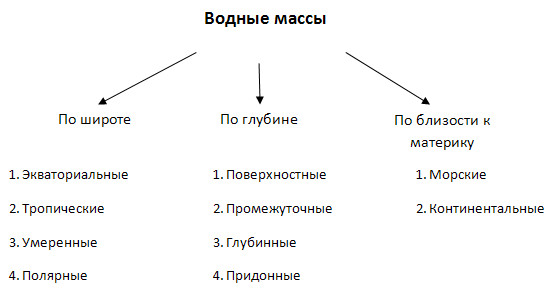
6. In the text of the textbook, select at least four reasons formation of currents in the oceans.
1. Influence of wind;
2. Uneven supply of solar heat at different latitudes;
3. Influence of the atmosphere;
4. Properties surface waters(salinity).
7. Show on the diagram the differences in ocean currents.
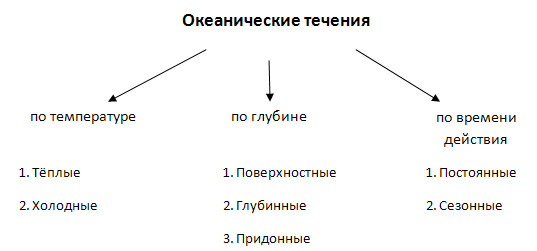
8. Using the text of the textbook, establish what conditions affect the distribution of life in the oceans.

Give examples of organisms that live:
a) in the surface layer of water - plankton, water striders;
b) in the water column - squid, whales, fish, turtles;
c) at the bottom of the ocean - starfish, oysters, flounders.
9. List the biological wealth of the oceans. Can they be considered inexhaustible?
The biological resources of the World Ocean include all animals and plants that live in its waters (for example, fish, molluscs, cetaceans). They can be considered inexhaustible due to their colossal size, but it's all about time ...
10. What changes can occur on Earth if the direction of the main surface currents in the World Ocean is changed (for example, to build a dam in the strait between the Florida Peninsula and the Cuba Island)?
There will be a global climate change on Earth. If a dam is built, it will block the Gulf Stream => in Europe, the climate will become much colder.
8. Geographic envelope.
1. Name the shells of the Earth that form the geographic shell.
Atmosphere, hydrosphere, lithosphere, biosphere.
2. What cycles exist in geographic envelope?
Water cycle, biological cycle, air cycle, cycles in the earth's crust.
3. Using the text of the tutorial, set the properties of the geographic shell.
1. Living organisms are everywhere in the geographic envelope.
2. The GO contains substances in solid, liquid and gaseous state.
3. All processes in Go proceed due to the solar and internal energy of the Earth.
4. All components of GO are linked into a single whole through the circulation of substances and energy.
5. All processes and components of GO are closely interconnected.
4. What is called latitudinal zoning?
This is a natural change in natural zones from the equator to the poles.
5. According to the text of the textbook, determine the similarities and differences between the latitudinal zonality, expressed in the plains, and the altitudinal zonality in the mountains.
Similarity: vegetation changes along the belts; latitudinal and altitudinal belts replace each other in a similar sequence: from the equator to the poles and from the foot of the mountains to the top.
Differences: the change of altitude zones in the mountains is much faster than the change of zones on the plains.
6. Formulate a pattern: the higher and closer to the equator of the mountain, the more altitudinal zones.
The lower and further from the equator of the mountain, the less altitudinal zones.
7. How would the altitudinal zonality change in the Caucasus mountains if they were located:
a) at the latitude of the equator; b) near the Arctic Circle? Make drawings.
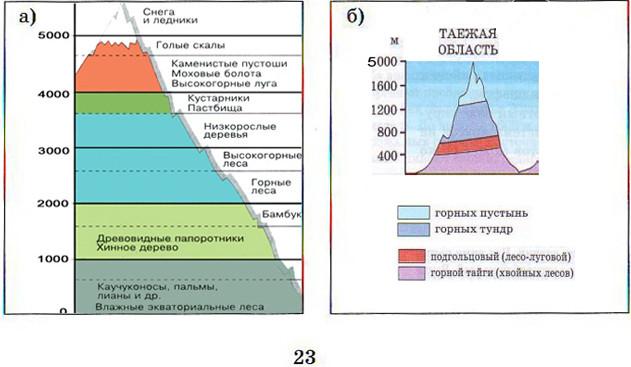
9. Why does any person need knowledge about the geographic shell, its structure and properties?
The geographic envelope is essentially our home. Therefore, it is important for us to know how it works, so as not to destroy it and keep it as beautiful for future generations.
9. The development of the Earth by man. Countries of the world.
1. The population of the Earth is 7 billion people. In which hemisphere do most people live?
In the Northern Hemisphere.
2. According to the text of the textbook, establish the characteristics of the ethnic group.

3. On what grounds can the countries of the world be grouped?
By geographic location, by area, by population, by religious composition, by the level of economic development.
4. Using the map of world population density in the atlas, determine how many cities in the world with a population of more than 3 million people.
44
On which continent are there most of them?
Eurasia
Which one is not enough?
Africa
5. On the comprehensive map of Australia in the atlas, determine the main types of economic activities of the population of this country.
Livestock, plant growing, mining.
6. Mark on the schematic map the areas of high population density, as well as the main directions of migration of people in the past and present.

7. In your opinion, will the division of humanity into races continue in the future? Why?
The division into races will remain, however, the Caucasoid race in the distant future will be too reduced or disappear.
8. In your opinion, the population of which continents will increase in the future? Why?
The population of Eurasia (in particular in Asia) and Africa, whose countries have a high birth rate ( historical factor).
10. Oceans.
1. According to the plan for describing the geographical position of the ocean in the textbook appendix, describe the Pacific Ocean.
1. Located between: Eurasia, Australia, North and South America, Antarctica. Connected with all oceans.
2. Located on both sides of the equator, relative to the prime meridian - in the Western Hemisphere. Crosses the North and South Tropics and the North and South Circles.
3. Located in all climatic zones, except for the north polar.
2. On the nature of which continent does the Pacific Ocean have the greatest influence? Why?
On the nature of Australia, the climate of which is significantly influenced by ocean currents.
3. What is the reason for the differences between the natural aquatic systems of the North Indian Ocean?
The northern part of the Indian Ocean lies in the tropical belt. Under the influence of the surrounding land and monsoon circulation, several aquatic complexes are formed in this belt, differing in the properties of water masses.
4. Why do currents in the northern Indian Ocean change direction according to the seasons of the year?
This is due to the monsoon type of atmospheric circulation (monsoon climate).
5. The Atlantic Ocean is the most studied ocean on the planet. Using the text and pictures of the textbook, systematize your knowledge about the stages of its study.

6. Why is the average salinity of waters Atlantic Ocean higher than the average salinity of the World Ocean?
In the Atlantic Ocean, salinity is distributed more evenly, which, in general, affects the greater salinity of the ocean as a whole.
7. Explain the relative poverty of the species organic world Atlantic Ocean compared to the Pacific.
The increased salinity, the relative youth of the ocean, does not have coral reefs.
8. What are the reasons for the great pollution of the waters of the Atlantic Ocean?
Extraction of oil and other minerals on the shelf, the development of shipping, a large number of cities on the coast.
9. What territories are included in the Arctic?
The outskirts of the continents of Eurasia and North. America and almost the entire Arctic Ocean with all its islands (except for the coastal islands of Norway), as well as the adjacent parts of the Atlantic and Pacific Oceans.
10. Name the most specific traits nature of the Arctic Ocean.
1. Polar position;
2. Arctic air masses prevail;
3. The presence of ice;
4. The Arctic Ocean does not cool, but warms the territories of the Northern Hemisphere.
11. The names of which explorers of the Arctic Ocean do you know?
G. Sedov, F. Nansen, O. Yu. Schmidt, I. D. Papanin, R. Amundsen.
12. Which continent supplies the Arctic Ocean with more fresh water? Why?
Eurasia: the largest rivers, for example, the Yenisei, Ob, Lena, etc., carry their waters into the ocean.
13. In what direction is the movement of ice in the Arctic Ocean? Who proved it?
In the direction of the currents. F. Nansen.
14. Explain the statement: "The Arctic Ocean, oddly enough, does not cool, but significantly warms the vast land areas of the Northern Hemisphere."
This is due to the heat reserve in the waters of the Arctic Ocean, which is constantly replenished by the warmth of the Atlantic waters (warm currents).
15. Which parts of the Arctic Ocean are rich in organic life? Why?
In that part of the Arctic Ocean, on the surface or at some depth of which the influence of relatively warm Atlantic waters(for example, Barents Sea, Kara Sea).
16. Name the types of human economic activity in the Arctic Ocean.
Fishing, offshore oil and natural gas production, sea transport.
17. What will happen to the nature of the Arctic Ocean if the inflow of water from the Atlantic and the inflow of river waters are reduced?
The salinity of the ocean will increase, the seas will begin to freeze.
18. Fill in the blanks.
Most of the deep-sea trenches in the Pacific Ocean. They are arranged in rings, because here is the junction of lithospheric plates. This area is called the Ring of Fire.
19. Identify the largest ports in the oceans:
a) Quiet - Vladivostok, Nakhodka, Singapore, Sydney.
b) Indian - Dubai, Mumbai, Chennai, Karachi.
c) Atlantic - Rotterdam, New York, Marseille, Hamburg.
20. Show on the schematic map with conventional symbols the types of economic activities of the population on the shelf of the oceans.

11. Africa.
1. Working with a contour map:
a) sign the names and coordinates of the extreme points of Africa;
b) sign large landforms;
c) designate the climatic zones of Africa and sign the main indicators of the climate for each zone;
d) sign large rivers, lakes.
![]()
2. What is the peculiarity of the geographical location of Africa?
Unequal land area north and south of the equator, which is important in the manifestation of the zoning of landscapes.
3. What assumptions about the features of the nature of Africa can be made on the basis of knowledge of its geographical location?
Hot and dry climate ( high temperatures, a small amount of precipitation), as a result - deserts.
4. How will it change geographical position Africa in millions of years, if the current direction of movement of the lithospheric plates remains? What changes will occur in this case in the climate of the mainland?
The African-Arabian Plate, which lies at the base of Africa, is moving northeast. In 100 million years, Africa will move 2300 km (2.3 cm / year) and will be located behind the Caspian Sea. Its climate will be temperate continental, which means hot summers, cold winters.
5. Determine what place in terms of area is Africa among the continents.
6. Which of the travelers explored the following territories of Africa (place the numbers)?

7. Africa was explored by travelers and scientists from many countries, and among them there were especially many representatives of Great Britain. How do you explain this?
This is due to the large number of British colonies in Africa.
8. By physical map of the atlas, establish how the border between "high" and "low" Africa is drawn.
From northeast to southwest
9. What forms of relief prevail on the mainland? Why?
Most of the continent is characterized by a flat relief. This is due to the old platform underlying the mainland.
10. On the physical map of Africa in the atlas, determine which objects the following heights belong to:
4165 m - Tubkal;
5895 m - wlk. Kilimanjaro;
4620 m - Ras Dashen;
5199 m - Kenya;
2918 m - Takhat city.
11. Establish patterns of distribution of sedimentary and magmatic minerals on the mainland. Fill the table.

Conclusion: minerals of sedimentary and magmatic origin are located on the coast of the Atlantic Ocean.
12. What type of climate is most common in Africa? Why?
Tropical type of climate, because the main part of the mainland is located between the tropics.
13. What determines:
a) the distribution of air temperatures on the mainland
- from the location of the climatic zone;
b) distribution of precipitation
- from air circulation.
14. On the climate map of Africa, determine:
a) the hottest is Dallol (Ethiopia);
b) the coldest - Sutherland (South Africa);
c) the driest is the Sahara Desert;
d) the wettest place on the mainland - Debundzha (Cameroon).
15. Why is the hottest place in Africa not at the equator?
V equatorial climate very humid (it rains often), which reduces the air temperature. Scattered solar radiation also predominates.
16. What climatic zone are characterized by:
a) dry hot summers and cool wet winter- subtropical;
b) dry hot winters and humid hot summers - subequatorial.
17. In June, July, August, the belts of atmospheric pressure over Africa are displaced: a) to the north; b) to the south. Explain the choice of the answer.
b, because during the year, the intertropical convergence zone is displaced from the equator by hundreds of kilometers to the hemisphere in which summer begins.
18. Explain the reasons for the unequal moisture content of the continent, which crosses the Southern Tropic.
This is due to sea currents and air masses above them. (West coast: cold currents - less humid air; east coast: warmer currents - more humid air).
19. On the climatic map of Africa in the atlas, make a characterization of the climate of the following items.
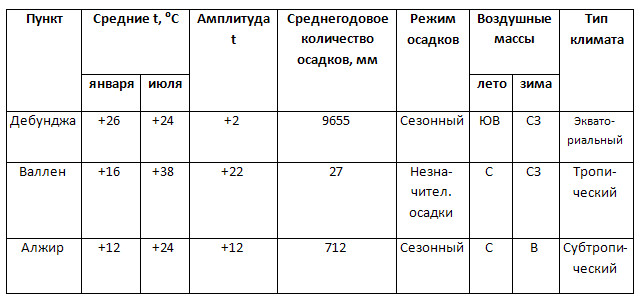
20. Conditions of what climatic zone in Africa is most favorable for the life of European immigrants? Why?
Subtropical zone: hot (+ 27-28⁰С) dry summers, relatively warm winter(+ 10-12⁰C).
21. Why do most of the rivers flow into the Atlantic Ocean?
This is due to the relief - in the east (and southeast) there are high plateaus and mountains.
22. In what months of the year does the Zambezi River flood? Explain the answer.
December and January, March and April. At this time, it rains, and the river is fed by rain.
23. On what river should you make a trip to visit almost all natural zones of Africa?
24. What are the characteristics of African lakes to judge the origin of their basins? Give examples.
By size, depth, coastal relief. For example, Tanganyika: elongated and narrow, deep, and, therefore, of tectonic origin.
25. Fill in the table using the text of the textbook and atlas maps.
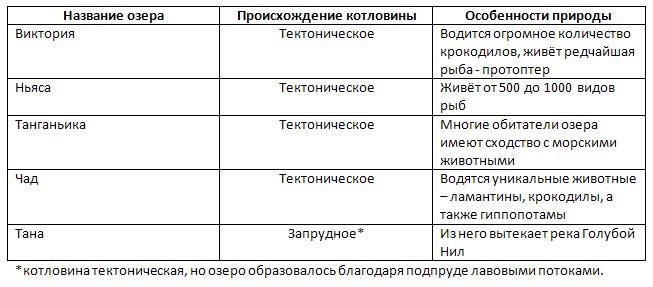
26. What is the peculiarity of the location of natural areas on the continent?
Africa is one of the few places on Earth where geographic zoning follows all the rules.
27. What natural zones are characterized by:
a) baobab, antelope, doom palm, marabou, cheetah
Savannah
b) oil palm, yellow tree, ficus, okapi
Wet equatorial forests
c) spurge, aloe, turtle, hyena, jackal
Tropical deserts
28. Define the natural area according to the description.
“The color of African seasons is the same all year round - green. Only in one period the green color is pure, bright, and in the other - faded, as if faded ... In the dry season, the earth turns to stone, grass - to bast, trees crackle from lack of juice. And now the very first downpour brings nature back to life. Having eagerly drunk water, the earth swells with moisture, generously gives it to trees, grasses, flowers. They drink, drink and cannot get drunk ... Almost every day the rain gushes in a powerful stream, or it pours in fine water dust. The air temperature drops, and locals shrug their shoulders chilly, complaining: "It's cold!" When the thermometer reads 18-20 degrees, some Africans believe that "frost" has come. They pull on everything they have from their clothes, tie their heads with kerchiefs, light bonfires in the streets, just to calm the tremors. " (L. Pochivalov)
Zone of humid equatorial forests.
29. Explain the reason for the low soil fertility of the equatorial forest.
Large amount of precipitation; rapid rotting caused by bacteria interferes with the accumulation of the humus layer.
30. On the diagram, use arrows to show connections in the natural complex of tropical deserts.

31. Which natural zones in Africa have the most national parks and reserves? Why?
Savannah, wet equatorial forests... A huge number of different animals live in these zones.
32. What natural disasters happen on the mainland? With the processes in which shells of the Earth are they connected?
Droughts, floods during the rainy season (atmosphere, biosphere).
The greater the desert, the greater the number of dust storms; desertification of lands adjacent to the Sahara; changes in flora and fauna.
34. Draw up a connection project on the schematic map river systems Africa and justify its necessity.
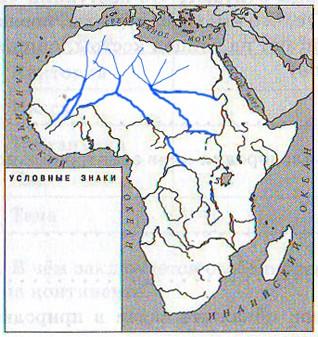
It is important to provide the population with fresh water North Africa for life, development of agriculture (canals, water (river) networks will make it possible to irrigate the land).
35. The population of Africa is approximately 1 billion.
36. On outline map US. 43 designate the largest peoples on the mainland.
37. Mark on a contour map such types of economic activities of the population of the continent as hunting, farming, mining.
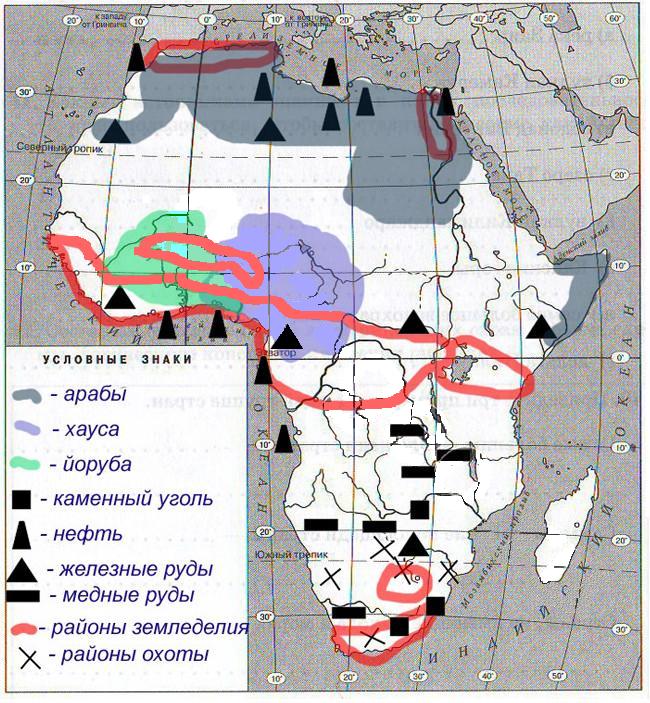
38. What peoples of Africa live:
a) in the deserts - Bantu, Bedouins, tubu, mosi;
b) in the savannas - Tutsis, Nilots, Masai;
c) in equatorial forests - pygmies;
d) on the highlands and plateaus - somalia, nilots, dinka.
39. In which countries are located:
a) the Zaire River - Congo, Democratic Republic Congo, Angola;
b) volcano Cameroon - Cameroon;
c) Victoria Falls - Zambia, Zimbabwe;
d) Lake Tana - Ethiopia;
e) volcano Kilimanjaro - Tanazia;
f) Cape Mountains - South Africa;
g) the largest reservoir - Uganda;
h) Nile delta - Egypt.
40. Give three examples for each group of countries.
The largest countries in terms of area are Sudan, Algeria, and the Democratic Republic of the Congo.
The smallest countries in terms of area are Swaziland, Lesotho, Gambia.
Landlocked countries - Chad, Niger, Mali.
The largest countries in terms of population are Egypt, Ethiopia, and the Democratic Republic of the Congo.
Countries, most of which lie in deserts - Niger, Chad, Libya.
The countries, most of which lie in equatorial forests, are the Democratic Republic of the Congo.
The countries on the territory of which the altitudinal zonality is expressed are Lesotho, Swaziland, Kenya.
41. What sources of knowledge and in what sequence should be used to compose a description of a country?
1. Atlas
2. Textbook, encyclopedia
42. Write a description of one of the African countries in the form of a diagram, a logical outline, or a series of pictures.
(according to the plan from the textbook, p. 313)
1. North Africa, Cairo.
2. Mainly flat relief; there are several plateaus; the most low point: Qattara Depression - 133 m; the most high point: Mount St. Catherine (Sinai) 2629 m.
Minerals: oil, natural gas, iron ores, phosphates, limestone, manganese, zinc, lead.
3. Egypt is located within the subtropical (northern part) and tropical (most) climatic zones, the tropical desert climate prevails; average temperatures in July + 29⁰С- + 33⁰С, January + 12- + 15⁰С; average annual quantity precipitation reaches only 180 mm.
4. Largest river- Neal.
5. Zone of deserts and semi-deserts (dust storms, low annual precipitation, high temperatures, sparse vegetation).
6. 98% of the population are Arabs (tourism, agriculture, light industry).
43. Expand the dependence of the nature of the dwellings of one of the peoples of Africa on natural conditions. You can make drawings.
44. Is it true that the population of the North African countries is engaged only in breeding livestock? Explain your answer.
It is not fair, because the population of some North African countries is also engaged in agriculture.
45. Why is South Africa ranked among the most economically developed countries in Africa?
South Africa is an industrial-agrarian country, which occupies one of the first places in the world in the extraction of gold, platinum, diamonds, manganese, chromium and antimony; there are oil refineries, ferrous and non-ferrous metallurgy plants, machine-building enterprises; the tourism business is also developed.
46. Make a forecast of the economic development of the Sahara.
Land use in the Sahara: pastures with hots of cultivated land, camel breeding.
12. Australia and Oceania.
1. Working with a contour map:
a) Sign the names and coordinates of the extreme points of Australia;
b) designate the climatic zones of Australia and indicate in numbers the change average annual quantity precipitation in areas that intersect the parallels 20 and 30⁰.
1 - Cape York 142⁰ east longitude 10⁰ S
2 - Cape Site-Point 146⁰E. 39 S.
3 - Cape Steep Point 113⁰ east longitude 26⁰ S
4 - Cape Byron 153⁰E 28 S.
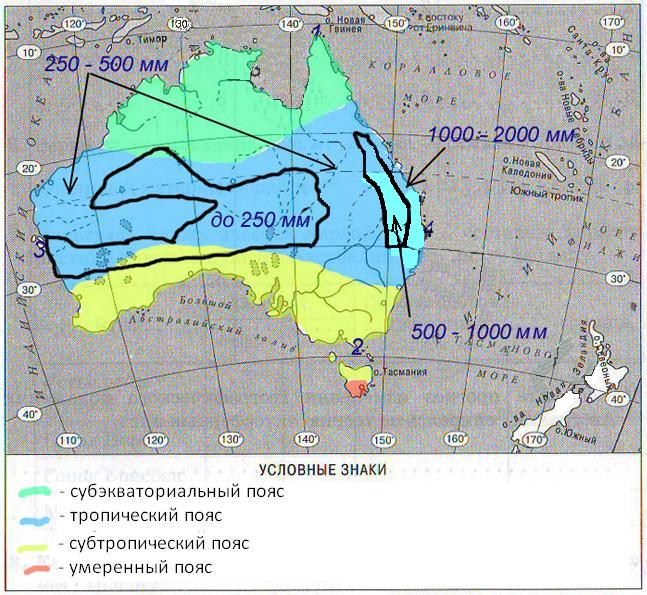
2. Compare the geographic location of Australia and Africa. Fill the table.
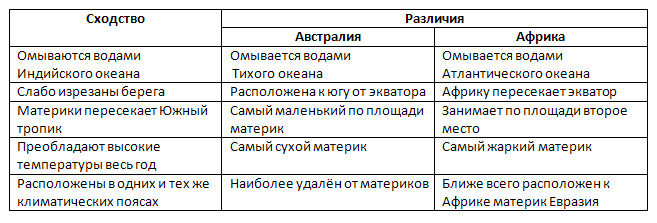
3. Make a forecast of changes in the geographical position of Australia, based on the theory of lithospheric plates.
The Indo-Australian Plate, on which Australia is located, moves northeast at a speed of 67 mm per year. In millions of years, the continent will approach Eurasia, and in billions it may reach North America.
4. What geographic objects Are Australia named after travelers, explorers and others?
Tasman Sea, about. Tasmania, Bass Strait, Cape Byron, Lake Air North.
5. What large parts in the relief of the mainland can be identified on the physical map?
1. Western Australian Highlands
2. Central lowland
3. Great Dividing Range
6. Is it true that Australia is the hottest and driest continent on our planet?
The statement is not true.
7. Using climate map Atlas, Characterize the Climate of Australia Points. Fill the table.

8. What areas of Australia and Africa have a similar climate? Why?
Northern Australia and central africa... This is due to the fact that the continents cross the tropics (Australia - the southern tropics, Africa - the northern and southern tropics; the climate is subequatorial).
9. When does Tasmania get a lot of rainfall? Why?
In winter (June, July, August). Tasmania is located in a subtropical climate zone, in which precipitation is associated with the arrival air mass from temperate latitudes.
10. Why is Australia poor in surface water?
This is due to the dominance of a dry tropical and subtropical climate on the mainland. (Most rivers on the mainland are fed by rain).
11. It is known that there are few rivers and freshwater lakes in Australia. How did you solve the problem of providing the population and the economy with fresh (or almost fresh) water?
The problem of providing the population and the economy with fresh water was solved through the construction of water desalination facilities.
12. What is the peculiarity of the location of natural areas in Australia?
A large area of Australia is occupied by zones of savannas and tropical deserts, which are located in the central and western parts of the mainland.
13. What are the differences between the Australian deserts and the Sahara:
a) by climate
The deserts of Australia receive more rainfall and the climate is less dry and hot;
b) vegetation
In the deserts of Australia, there are no significant areas of "absolute" deserts practically free of vegetation;
c) in the animal world
The fauna of the Australian deserts is the most diverse;
d) inland waters
The Sahara is a wastewater area, most of the Australian deserts are inland flows; unlike the Australian deserts, the Sahara is rich in groundwater.
14. What plants and animals brought to the mainland contribute to the disruption of connections between the components of nature?
Dogs, sheep, rabbits, cows.
Cacti, aloe, oak, poplar.
What components of Australia's nature have been most modified by humans?
Vegetation and animal world; savannahs and woodlands in large areas have been plowed up or turned into pastures.
15. Where are the most big cities Australia? Why?
In the southeast, east and extreme southwest of the country. These areas have the most favorable natural conditions, and earlier than others, they were settled and developed by immigrants from Europe ( natural conditions and the historical factor).
16. How would Australia's climate change if the Great Dividing Range were located on west coast mainland?
Australia's climate would become more humid -> the area of deserts would decrease.
17. Determine on the map which islands in Oceania are:
a) mainland
New Guinea, New Zealand;
b) volcanic
Fiji, New Caledonia, Samoa;
c) coral
Gilbert, Tuamotu.
18. What natural resources do the islands of Oceania have? How does the population use them?
Agroclimatic and natural resources... The economy of most countries in Oceania is based on agriculture and fisheries. Extraction of minerals is also carried out.
19. What components of the nature of Oceania have been particularly affected by the economic activities of people?
Flora and fauna, soils, surface waters.
13. South America.
1. Working with a contour map on p. 53:
a) sign the names and coordinates of the extreme points South America;
b) sign the seas and oceans washing South America, peninsulas, bays, islands;
c) sign the main landforms;
d) show the main deposits of minerals;
e) Identify the climatic zones of South America and sign the main climate indicators for each zone.
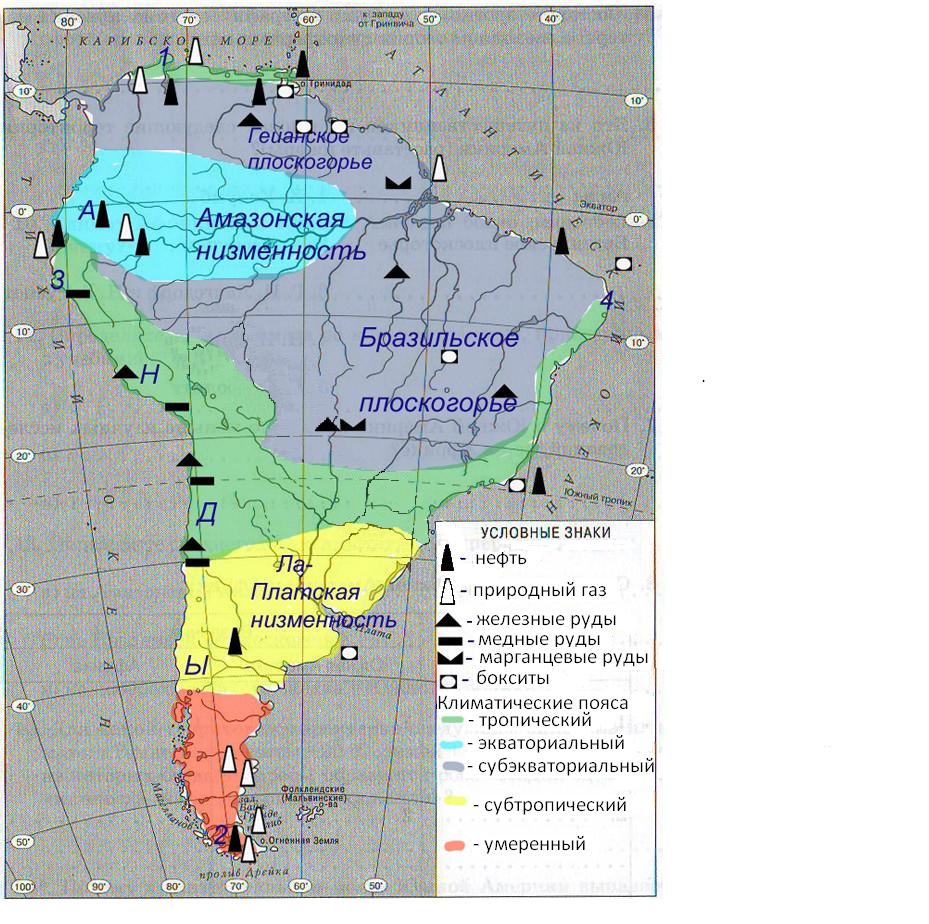
1 - Cape Galinas 12⁰ N, 71⁰ W
2 - Cape Froward 53⁰ S, 71⁰ W
3 - Cape Parinyas 4⁰ S, 81⁰ W
4 - Cape Cabo Branco 7⁰ S, 34⁰ W
2. Why does the mainland have a fairly simple outline?
The impact of the ocean on the coastline is not significant because the banks are hard rocks.
3. Compare the geographic location of South America and Africa. Fill the table.
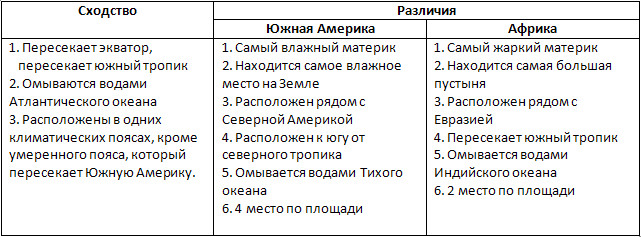
4. On the physical map of South America in the atlas, compare the area of the shelf at the eastern and western shores mainland. Explain the result.
The shelf area near the eastern shores is larger, because the western ones, which are washed by the Pacific Ocean, have a large number of deep-sea trenches.
5. Make a forecast of changes in the geographical position of the continent, based on the theory of lithospheric plates.
South America is moving west. As a result, in about 200 million years, it will merge with Eurasia.
6. Which of the travelers explored the following territories of South America (place the numbers)?

7. Why is there less research done in South America than in Africa?
In Africa, there were colonies of the more developed states at that time - Great Britain and France, which conducted research on the territories.
8. Compare the relief of South America and Africa.
9. The relief of the Amazonian lowlands and the Brazilian highlands formed on the same platform, but it is different. Why?
The Brazilian Highlands were formed as a result of prolonged destruction of the South American Plate and vertical movement, and the relief of the Amazonian Lowland - in its troughs.
10. Is the climate of Africa or South America more diverse? Why?
South America. This is due to the more diverse topography of the mainland.
11. Determine the types of climate by climatograms given in the textbook: Fig. 72, p. 171.
a) Subequatorial
b) Tropical
c) Equatorial
12. Determine the average annual amplitude of air temperatures:
a) on the Amazon lowland 0⁰С;
b) on the Brazilian plateau 0⁰С;
c) on the Pacific coast near the Southern Tropic 8⁰С.
13. For which territory the following climate description is typical: “The temperature in summer is + 20⁰С, in winter + 13⁰С, fogs are frequent, from which drizzle settles, dew is formed. Precipitation is rare here, sometimes not a drop falls in a year ”?
Pacific coast.
14. Why in equatorial belt South America receives more rainfall than the same belt in Africa?
The Andes impede the passage of air masses from the Atlantic Ocean, and therefore a large amount of precipitation falls.
15. How do they change climatic conditions on the west coast of the mainland, when warm waters replace the Peruvian Current?
Heavy rains are falling in the Atacama Desert.
16. Compare the climate of South America and Africa. Fill the table.

17. What are the reasons for the ample water in the Amazon and why does the water level in it rise twice a year?
The Amazon is full of water because its northern and southern tributaries are located in different hemispheres. Accordingly, floods occur at different times of the year (on the right tributaries - from October to April ( summer season in the Southern Hemisphere), on the left - from April to October (summer season in the Northern Hemisphere)).
18. Name the months of the year during which the Parana River floods. Explain the reasons for this.
The river is fed by rain. The maximum rainfall in summer is January - May.
19. Are natural areas more diverse in South America or in Africa? Why?
In South America. This is due to the more varied climate.
20. Name characteristic signs humid equatorial forests of South America.
The average annual air temperature is 25-30⁰С; the annual amount of precipitation is more than 2000 mm per year; rivers and lakes are deep throughout the year; the forests are characterized by a three-tiered structure of the tree canopy; Flora and fauna rainforest very diverse.
21. Using the atlas map, determine in which natural zone of South America there are especially many reserves. Why?
The humid equatorial forests are a region of the Amazon. An array of forests that affects the Earth's climate and the hydrological regime of the Amazon, and contains a huge number of different species of plants and animals.
22. In which part of the Andes (at the equator or at the Southern Tropic) there are more altitudinal zones? Why?
The greatest number of belts is at the equator, where the foothills of the mountains are covered with equatorial forests, and on the peaks there are eternal snow and ice.
23. Are the natural conditions of South America favorable for the life and economic activities of the population?
Relief - has an adverse effect only on the highlands of the Andes.
Climatic - conditions are favorable mainly in the pampas (subtropical continental and temperate climate).
Inland waters are the richest (in abundance).
Difficulties - impenetrable jungle, swamps, numerous streams.
Opportunities - extraction of timber, rubber, oil; construction of a hydroelectric power station.
25. Using arrows of different colors, indicate the stages of the settlement of South America.

26. What are the reasons for diversity ethnic composition mainland population.
The main reason is the historical development of the mainland. The indigenous people of South America are Indians; from the 16th century, colonization by Europeans began, who, to work on plantations, began to import blacks - slaves from Africa.
27. Show on the diagram using the arrows the complexity and diversity of the racial composition of the population of South America.

28. What is the difference between the living conditions of the Indians of the Amazon and the Indians of the Andes?
Amazon: Seasonally flooded plain, jungle.
Andes: little oxygen, huge temperature fluctuations, high humidity.
29. Why, despite the mountainous terrain, in the west of South America high density population?
The historical factor (ancient civilizations of the Indians) is decisive.
30. Name state languages mainland countries.
Brazil - Portuguese;
Peru - Spanish and Quechua;
Argentina - Spanish;
Guyana - English.
31. Give examples of countries:
a) with a large area - Brazil, Argentina, Peru;
b) with a small area - Uruguay, Guiana, Suriname;
c) landlocked - Paraguay, Bolivia;
d) with mountainous relief - Bolivia, Chile, Peru;
e) with a large number of neighbors - Brazil.
32. In which countries are the following facilities:
a) Angel Falls - Venezuela;
b) Lake Maracaibo - Venezuela;
c) Chimborazo volcano - Ecuador;
d) Atacama Desert - Chile;
e) the mouth of the Parana - Argentina, Uruguay;
f) the origins of the Amazon - Peru;
g) most of the pampa - Argentina.
33. On a schematic map of Brazil, use conventional symbols to reflect the natural resources of the country and the types of economic activities of the population for their use.

34. Use the Atlas Population Density Map to determine where most of the Brazilian population lives. Why?
On the Atlantic coast. This is due to the historical development of the territory.
35. Explain the reasons for moving the capital of Brazil inland.
Economic and social reasons: for the opportunity to develop the internal regions of the country.
36. How did the construction and use of the Trans-Amazonian highway affect the nature and economic activities of the population?
For nature: deforestation, environmental degradation.
For economic activities: development of adjacent areas (economic and cultural growth), improvement of trade and passenger transport.
37. What is the richness and diversity of Argentina's nature?
In natural areas: from polar ice and the tundra, to the pampas and the tropics.
38. Why is the use of natural resources of Peru so difficult?
The inaccessibility of the territory where these resources are located ( mountainous areas, selva); relatively weak economic development Peru.
39. In which countries of the mainland nature has suffered the most as a result of human activities? Why?
Brazil, Chile (deforestation, mining, industrial production); Venezuela (oil production).
1. Mineral resources - high;
2. Climate - low;
3. Water - medium;
4. The soil is low;
5. Flora and fauna - average.
14. Antarctica.
1. What parts the earth's surface includes an area called Antarctica?
South polar region the globe, including Antarctica and the adjacent areas of the Atlantic, Indian and Pacific oceans.
2. Reflect in the table information about the discovery and study of Antarctica.

3. Describe the geographical position of Antarctica according to the plan in the appendix of the textbook.
1. Crosses the Antarctic Circle (completely located in the polar region of the planet), located in the Southern Hemisphere, crossed by the zero meridian.
2. Northern extreme point - Cape Sifre 63⁰ S, 57⁰ E.
3. Located in the subantarctic and antarctic climatic zones.
4. Washed by the waters of the Atlantic, Indian and Pacific oceans.
5. It is separated from other continents by a huge oceanic space (the nearest is South America).
4. Determine in degrees and kilometers the distance from Antarctica to:
a) Africa 36⁰, 3980 km;
b) South America 9⁰, 1000 km;
c) Australia 28⁰, 3100 km.
5. Establish the differences in the relief of the western and eastern parts Antarctica. Justify your answer.
At the base of the eastern part is an ancient platform (the surface is an elevated plateau), and Western part lies within the Cenozoic folding (it is a young mountain structure).
6. On the climatic map of Antarctica, determine:
a) average temperature air in January in the center of the mainland -23⁰С, on the coast 0- + 5⁰С;
b) the average air temperature in July in the center of the mainland -60⁰С, on the coast -18⁰С;
c) the minimum air temperature is -89.2⁰С;
G) maximum temperature air + 14.6⁰С.
7. Name the typical representatives of the organic world of Antarctica.
Mammals are seals;
Birds - petrels, skuas, penguins.
8. Using the text of the textbook, draw a picture of the Antarctic oasis.
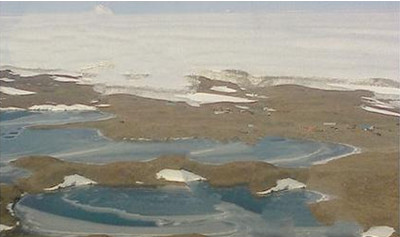
9. Try to draw an iceberg formation from an Antarctic ice shelf.
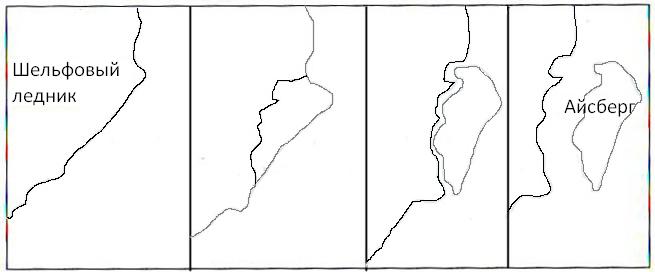
10. In what components of the nature of the continent is latitudinal zoning manifested?
In the distribution of precipitation and temperatures.
12. Name the direction of the possible use of natural resources (and even geographic location) of Antarctica for scientific and economic purposes.
Exploration and mining, possibly melting ice for fresh water, designing cities of the future in Antarctica.
13. Suggest a list of conservation measures to be taken in Antarctica.
Fishing restrictions;
reducing the number of equipment that pollutes the environment;
removal of all garbage for disposal outside the mainland.
15. North America.
3. Determine the extent of North America in degrees and kilometers by:
a) meridian 100 ° W. - 51⁰, 5676 km;
b) the Arctic Circle - 40⁰, 1060 km;
c) Northern Tropic - 9⁰, 1060 km.
4. In which direction from the Labrador Peninsula are located:

5. Which of the travelers discovered or explored the following territories (fill in the numbers)?

6. Name the explorers whose names can be found on the map of the mainland.
Amerigo Vespucci, George Vancouver, Hudson Henry, Baffin William, Bering Vitus Ionassen.
12. The Florida and California peninsulas are located in the same climatic zone, but their climate is different. Explain the reasons for this fact.
Florida's climate is defined by its warm Caribbean and the Gulf Stream, California - cold Pacific currents.
13. On the climatic map of North America in the atlas, describe the regions of the temperate climatic zone:
a) with a maritime climate
tw January 0, -8⁰С
tw July +10, + 12⁰С
average annual precipitation 2000-3000 mm
b) with a continental climate
tw January -8, -16⁰С
tw July +16, + 24⁰С
average annual precipitation 500-1000 mm
14. Using one of the climatograms in the textbook, determine the type of climate and explain how you found the answer.
Subarctic climate (p. 212, first climatogram).
15. Which ocean has the greatest impact on the climate of the mainland? Why?
The Atlantic Ocean has the greatest impact on the climate of North America, because there are no mountains on the east coast that would prevent the penetration of air masses into the interior from the Atlantic.
16. Which areas of the continent are well supplied with fresh water, and which ones are experiencing a shortage of it?
Much of the inland Cordillera Highlands, Northern Mexico (especially the Mexican Highlands), much of the island of California, and the northern coast of the Gulf of California are water scarce. The western regions of the mainland are well supplied with fresh water.
17. Where are the largest number of lakes located on the mainland? Why?
In the northwestern part of the mainland (Great Lakes), because these lakes have glacial origin(soft rocks were plowed out by the body of the advancing glacier, and after the retreat of the glacier, the formed craters were filled with melt water).
18. Name the natural areas of North America:
a) the biggest
Zones of tundra and forest-tundra, forest-steppe and steppe
b) the smallest in area
Zones of semi-deserts and deserts, savannas and woodlands.
19. What natural zones are the following plants and animals typical for:
a) tulip tree, sugar maple - mixed forests;
b) fescue, bearded, bison, coyote - steppes;
c) black and white spruce, fir, beaver, aspen poplar, wolverine, elk - taiga;
d) berry dwarf shrubs, musk ox, arctic fox, caribou - tundra.
20. What types of soils are typical for the zones:
a) tundra - tundra-swamp;
b) taiga - podzolic;
c) prairies - black earth and chestnut.
28. Using the population density map in the atlas, determine which part of North America has the most cities? Why?
In the southeastern part of North America, which is associated primarily with the history of the settlement of the mainland.
Canada is rich in a variety of mineral, forest, and water resources.
The United States is endowed with (almost) all natural resources.
Mexico is provided with a variety of mineral resources.
Which country has the greatest natural wealth? Why?
USA, since are distinguished by a wide variety of natural conditions.
30. Use the population density map in the atlas to determine which part of Canada has the highest population density. Why?
The most favorable climatic conditions are in the south of Canada (200-500 km zone along the border with the United States), therefore, there is also the main zone of settlement (the highest density).
31. Write down the titles of the books from which you learned about the nature and life of people in North America.
IP Mamdovich “History of Discovery and Exploration of North America”; D. Bakles "America through the eyes of the discoverers"; "Countries and Peoples" volume "North America" (from fiction: Jack London "Smoke Bellew" (on the nature of the Alaska Peninsula); D. Defoe "Robinson Crusoe" (on the nature of the Caribbean islands)).
16. Eurasia.
1. Work with the contour map at the station. 77:
a) sign the name and coordinates of the extreme points of Eurasia;
b) sign the seas washing Eurasia, peninsulas, bays, islands;
c) sign large lakes, rivers and mark the predominant type of their feeding (D - rain, L - glacial, S - snow, C - mixed), and for rivers also the time when they flood (1 - winter, 2 - spring, 3 - summer, 4 - autumn).
2. Describe the geographical location according to the plan in the appendix of the textbook.
The area is 53.4 million km2.
1) Position relative to the prime meridian, the equator.
Eurasia is not crossed by the equator, so it lies entirely in the northern hemisphere. The mainland is crossed by the zero meridian and the 180 meridian. Eurasia lies in the eastern and western hemispheres.
2) What oceans and seas is washed by.
Eurasia is washed by the waters of all four oceans. In the north - the Arctic, in the east - the Pacific, in the south - the Indian, in the west - the Atlantic Ocean.
3) Continents are neighbors.
Eurasia borders Africa through the Suez Canal and the Strait of Gibraltar. Through the Bering Strait, the mainland borders on North America.
4) Heat zones.
Eurasia lies in hot, temperate and cold heat zones.
5) Extreme points, coordinates.
Extreme north point- Cape Chelyuskin (78 ° north latitude, 104 ° east longitude.)
The southernmost point is Cape Piai (1⁰ North latitude, 103 ° East longitude.) The westernmost point is Cape Roka (39 ° North latitude, 9 ° West longitude.) The easternmost point is Cape Dezhnev (66⁰ North latitude, 170 ° East longitude) .)
3. Using the data of the textbook, determine what part of the Earth's area is Eurasia (in percent).
The area of the Earth is 510,000,000 km2. The area of Eurasia is 54,000,000 km2.
510000000 – 100%
54,000,000 - x
x = (54,000,000 * 100) / 510,000,000 = 10.5%.
4. Determine the length of Eurasia in degrees and in kilometers:
a) from north to south.
To find out the length of Eurasia from north to south, it is necessary to determine the latitude of the extreme north and south point mainland. The latitude of Cape Chelyuskin is 78 ° north latitude. The latitude of Cape Piai is 1 ° north latitude.
78 ° - 1 ° = 77 °.
Since the length of the 1 ° meridian is 111.3 km, then 77 ° * 111.3 = 8126 km
b) from west to east.
To find out the length of Eurasia from west to east, it is necessary to determine the longitude of the extreme western and east point mainland. The longitude of Cape Roca is 9 ° W. The longitude of Cape Dezhnev is 170 ° West longitude.
Find the distance in degrees between the points.
9 ° + 180 ° + (180 ° - 170 °) = 199 °.
Since 1 ° along the 40th parallel is 85.4 km, then 199 * 85.4 = 16 996 km.
Calculate the distance
a) from Cape Chelyuskin to the North Pole in degree
90 - 78 = 12 (degrees),
in kilometers
12 * 111, 3 = 1336 km
b) from Cape Piai to the equator in degree measure
1 - 0 = 1 (degree),
in kilometers
1 * 111.3 = 111.3 km
5. Which shores of Eurasia are the most indented? Why?
The most indented shores of the Scandinavian Peninsula, which is explained by the activity of the ancient glacier. The shores are also heavily indented Southern Europe... The reason for this is that the Mediterranean Sea cuts deep into the land.
6. What geographic features of the mainland are named after travelers:
V. Barents - Barents Sea, Barents Island
S. Chelyuskin - Cape Chelyuskin.
V. Bering - Bering Sea, Bering Strait, Bering Island, Bering Glacier.
S. Dezhnev - Cape Dezhnev.
D. and H. Laptev - the Laptev Sea.
7. How will the outlines of Eurasia change if it coastline will coincide with the mainland border crust? Show your answer with a dotted line on the outline map on page 77.
8. Write down the landforms that intersect:
a) meridian 80 ° E
West - Siberian Plain, Kazakh Upland, the Tien Shan mountains, the Kun Lun mountains, Tibet, the Himalayas, the Indo-Gangetic lowland, the Deccan plateau.
b) parallel 40 ° N. NS.
mountains of the Apennines, Balkans, Turan lowland, Tien Shan.
9. Where is most of the mountain systems Eurasia? Why?
The mountains of Eurasia are located in the south and east of the mainland. They were formed as a result of the collision of lithospheric plates.
10. Where are the zones of earthquakes and modern volcanism in Eurasia? Why?
The largest number of earthquakes and volcanism in Eurasia are concentrated in the places of collision of lithospheric plates. As a result, the seismic belts of the Alpine - Himalayan and Pacific Ocean were formed. Largest volcano Eurasia is a volcano Klyuchevskaya Sopka in Kamchatka. Also active volcanoes available on the Apennine Peninsula, Iceland
11. How was the Indo-Gangetic lowland formed? What plains of Eurasia have a similar origin?
The Indo-Gangetic lowland was formed by the sediments of the Indus and Ganges rivers. The Mesopotamian lowland was also formed by the sediments of the Tigris and Euphrates rivers and the Padan lowland by the Po river.
12. Establish patterns of distribution of Eurasian minerals. Fill the table.
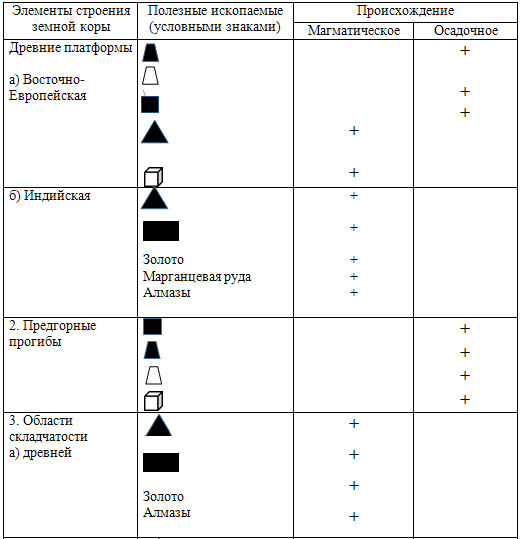
13. Why are deposits of minerals of magmatic origin located not only in the mountainous regions of Eurasia, but also on the plains?
Since the platforms correspond to the plains, crystalline rocks of magmatic origin lie at their base. Sometimes these rocks come to the surface to form shields.
14. Which territories of Eurasia are especially rich in oil? Why?
These are the Arabian Peninsula, Western Siberia, the North Sea shelf. This is due to the significant accumulation of sedimentary rocks.
15. How do you think in what part and due to what will the increase in the area of Eurasia take place? Why?
The area of Eurasia is increasing due to the uplift of some territories. This is the Scandinavian Peninsula, the Jutland Peninsula.
16. Identify points in Eurasia:
a) the coldest - the city of Oymyakon (-70 ° C)
b) the hottest - the Arabian Peninsula
c) the driest - the Rub al - Khali desert (Arabian Peninsula) (35 mm of precipitation per year)
d) the wettest - the city of Cherrapunji (12,000 mm of precipitation per year)
17. What is the influence of the oceans washing it on the nature of Eurasia:
Quiet - for east coast the monsoon type of climate is characteristic, as well as the influence of the warm Kuroshio Current.
Atlantic - the influence of the warm North Atlantic Current and westerly winds from the ocean
Indian- influenced by monsoon winds from the ocean.
Northern Arctic - cold and dry air masses.
18. Using the climatic map of Eurasia in the atlas, establish the features of the course of the zero isotherm on the continent. Explain the reasons.
The zero isotherm in the west of the continent passes in its northern part, which is explained by the influence of the warm North Atlantic Current. In the interior of the continent, it sinks far to the south, because the continentality of the climate increases. In the east of the mainland, the isotherm rises again to the north, as the warm currents of the Kuroshio and North Pacific Ocean pass in the east.
19. In what climatic zones is Eurasia located? Why?
Eurasia is located in the arctic, subarctic, temperate, subtropical, tropical, subequatorial, equatorial climatic zones. This is due to its considerable length from north to south.
20. Complete the table.

21. In which climatic zone of Eurasia there are especially many climatic regions? What is the reason for this diversity?
In the temperate zone. This is due to its considerable length from west to east.
22. To what climatic zones are the climatograms given in the textbook?
23. Using the text of the textbook and the climatic map of Eurasia in the atlas, make a description of the climate of the Apennine Peninsula and the Korea Peninsula. Fill the table.
![]()
Conclusion: The climate of these peninsulas differs in its indicators, since the Apennine Peninsula is characterized by a subtropical and temperate type of climate, and for the Korea Peninsula it is a moderate monsoon.
24. Using the climatic map of Eurasia in the atlas, make a description of the climate of the Indian subcontinent and the Arabian Peninsula. Fill the table.

25. The climate of what areas of the continent is most favorable for human life? Why?
The most favorable climate is with moderate temperatures in summer and not low temperatures in winter with sufficient rainfall. Such territories are Western and Central Europe.
26. The climate of what territories of Eurasia would change if the height of the Himalayas was no more than 1000 m?
The climate of both South Asia and Central Asia would change. The wet summer monsoon would penetrate further into the interior of the mainland, and the winter monsoon would bring in South Asia drier and colder air.
27. To the basins of which ocean does most of the territory of Eurasia belong?
The Arctic Ocean.
28. In what months do the rivers of Southern Europe flood? Why?
The rivers of southern Europe overflow during the winter months. The reason for this is that this area lies in a subtropical climate zone of the Mediterranean type. And in winter, this part of Europe is influenced by a tropical air mass, which is dry and warm.
29. What is the similarity of the regime of the rivers of Eurasia related to the basins of the Pacific and Indian oceans?
The rivers of the Pacific and Indian Oceans are similar in that the main source of their food is monsoon rains. High water on these rivers occurs in summer.
30. Rivers of what territories of Eurasia do not freeze? Give examples.
The rivers that lie in the equatorial, subequatorial, tropical and subtropical climatic zones do not freeze. These include: the rivers of South Asia (Indus, Ganges), South-East Asia(Yangtze, Yellow River), Southern Europe (Po).
31. What is the role inland waters Eurasia in the life of the population?
The importance of inland waters for the life of the population is very great.
1. A source of fresh water for a significant part of the population.
2. Large transport routes.
3. A source of cheap electricity.
4. Fish catch.
5. Tourism object.
32. What rivers of Eurasia bring many troubles to people living along their banks? Why do these troubles happen? How do people prevent them?
Natural disasters that are associated with rivers include floods, congestion, and erosion of banks. These rivers include rivers Western Siberia, mountain rivers temperate zone... The reason is climate change and human economic activity. People are struggling with these phenomena: they plant forests along the banks, blow up congestion, and build dams.
33. On the map of natural zones of Eurasia in the atlas, determine which zone occupies:
a) largest area- taiga.
b) the smallest area - equatorial forests, arctic deserts.
34. Explain the features of the location of natural areas of the mainland:
In the north of the mainland, natural zones stretch in a continuous strip. South of the taiga, they are replaced not only from north to south, but also from west to east. In the west and east of the mainland, there are zones of deciduous forests, and inside the mainland there are zones of forest-steppe and steppes, semi-deserts and deserts. This location is explained by a decrease in the amount of precipitation from the outskirts of the continent, an increase in continentality to the interior. In general, the natural zones of Eurasia are more diverse than on other continents of the globe.
35. Determine the similarities and differences in the alternation of natural zones of Eurasia and North America, located along the 40th parallel.
Similarity: in the eastern part of the continent of both continents there are natural zones of steppes and forest-steppes.
Differences: since Eurasia has a significant length from west to east, the number of natural zones on it is greater. In North America, 40 ° N. NS. there are no deserts.
36. On which plains of Eurasia is the law of latitudinal zoning most clearly manifested?
Change natural complexes in latitude it is clearly traced on the East European Plain, West Siberian Plain.
37. What natural zones of the continent are typical for:
a) dwarf birch, lemming - tundra and forest-tundra
b) vanilla, teak and lard trees, elephant - savannah and woodlands
c) myrtle, stone oak, wild rabbit - zone of evergreen hard-leaved forests and shrubs (Mediterranean)
d) feather grass, fescue, bustard - steppe zones
e) camphor laurel, camellia, magnolia, bamboo bear - a zone of variably humid (including monsoon) forests.
38. Describe or draw the appearance of the summer tundra, winter taiga, hard-leaved evergreen forests and shrubs of the Mediterranean type (two zones to choose from).
Natural area: Tundra - natural area in the north of the mainland, which has a characteristic subarctic climate. The winters are very harsh and the summers are slightly warmer. There are a lot of swamps. In warm weather, the tundra comes to life. A huge number of birds arrives: geese, brants, rose gulls, swans. A huge number of flowers bloom, berries ripen: lingonberries, blueberries, cranberries.
Eurasia - grade 7, Dushina.
Natural zone: Taiga is a zone of temperate coniferous forests. Winter in this area is quite cold and snowy. At this time, life in the taiga stops. Small rodents hide under the snow. In severe frosts, some birds also hide in the snow: black grouse, wood grouse, hazel grouse. Some animals, however, are forced to hibernate for a long time. These include the brown bear and the common badger.
Eurasia - grade 7, Dushina.
39. Give examples of the mountains of Eurasia, where the altitudinal belts:
a) many: the Himalayas, Tien Shan, Caucasus, Pamir.
b) little: Ural, Scandinavian,
Explain the reasons for the differences:
1. There are many altitudinal zones, because these mountains are of considerable height, and are also located closer to the equator.
2. There are few belts, since these mountains are not very high.
40. Compare the deserts of the Karakum, Takla-Makan, Ruble-al-Khali. Fill the table. 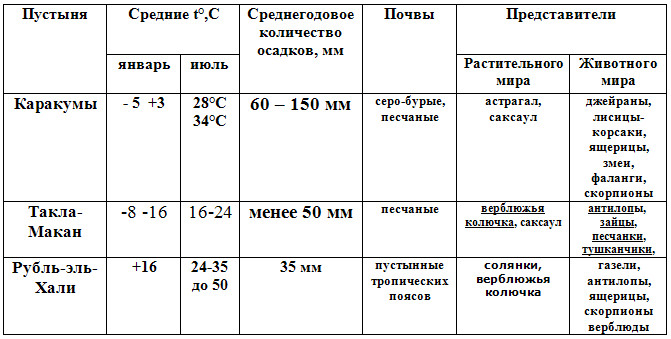
Indicate the difference in the nature of these deserts and their reasons:
Ruble al-Khali is the hottest desert because it is located in a tropical desert type of climate.
Takla Makan is one of the harshest - an inland desert surrounded on all sides by mountains.
41. Indicate the largest and smallest peoples of Eurasia. Fill the table.
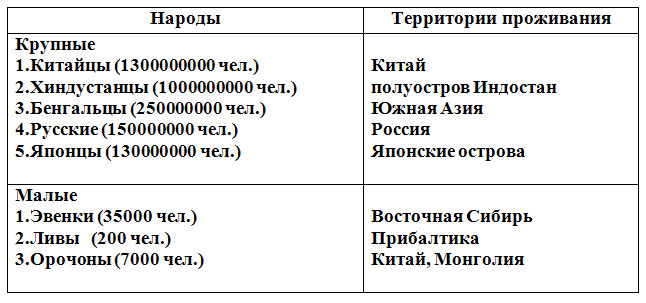
42. Indicate climatic zones and natural zones:
a) with the highest population density: temperate, subtropical, subequatorial.
Natural zones: steppe, forest-steppe, savannah, mixed and deciduous forests.
b) with the lowest population density: arctic, subarctic, tropical.
Natural areas: arctic deserts, tundra, tropical deserts
43. Name the five peoples of Eurasia who live:
a) on the plains: Poles, Danes, Germans, Moldovans, Belarusians
b) in the mountains: Nepalese, Kyrgyz, Tibetans, Pashtuns, Tajiks
44. What peoples of the mainland live in the zone:
a) taiga: Finns, Swedes, Norwegians, Evenks.
b) mixed and deciduous forests: Belarusians, Germans, Poles, Latvians, Estonians.
c) deserts: Arabs of the Arabian Peninsula, Uzbeks, Turkmens.
d) savannah: Tamils, Sinhala, Oraons, Veddas.
e) equatorial forests: Malays, Dayaks, Ibans.
45. Mark on the contour map on page 90 the territories where the rural population is engaged in hunting, agriculture, nomadic and semi-nomadic livestock raising, and sea fishing. Come up with the symbols yourself.
46. Mark on the outline map on page 90, the largest cities of the mainland, sign their names. Highlight the capitals.
47. Make a "catalog" of the countries of Eurasia, grouping them according to various criteria. Determine the grounds for grouping yourself. Present the result of the work in the table. 
48. On political map Eurasia, establish which countries of Eurasia have:
a) land borders with only one or two countries: Portugal, Monaco, San Marino, Vatican, Ireland;
b) a large number of neighboring countries: Russia, Ukraine, China, Belarus, Austria, Switzerland, Germany, France.
49. In which countries are located:
a) Bosphorus Strait - Turkey;
b) Mount Chomolungma - Nepal, China
c) Dead Sea - Israel, Jordan;
d) Hekla volcano - Iceland;
e) Krakatoa volcano - Indonesia;
f) Lake Lop Nor - China;
g) Lake Geneva- Switzerland, France;
h) Elbe River - Czech Republic, Germany;
i) Yangtze River - China.
50. Show on a schematic map of the features of the economic activity of the population of China. Sign major cities.
51. Using maps and other sources, make a description of one of the countries overseas Europe or overseas Asia... Express it in a drawing, diagram, schematic map; use symbols instead of words.
52. Describe the geographical location of one of the cities in Europe and one of the cities in Asia. Fill the table.

53. Give an example of the influence of the natural environment on the type of dwellings, the material from which they are built, national clothing, food, customs and rituals of the peoples of Eurasia. Draw a drawing.
Northern peoples live in the harsh conditions of the arctic and subarctic climatic zones... The main occupation of these peoples is hunting for sea animals and reindeer herding. Therefore, their dwellings are made from the skins of sea animals or reindeer. The main food products are the meat of these animals. Clothing should protect from severe frosts in winter, and from midges and mosquitoes in summer.
Among the northern peoples, deaf (without a cut, worn over the head) clothing prevailed.
Eurasia - grade 7, Dushina.
who pours into the water and how often.
Riga seems to be from 5 to 11 meters above sea level, if you go up high waves, this is quite enough to flood all of us, and 6 meters will flood us with calm
Even if every inhabitant, including babies, "puffs" 1 liter of liquid. This will be about 6 billion liters.
the area of the world's oceans is 361 million square kilometers
Those. for 1 square kilometer, you get about 16 liters of liquid.
You can blow calmly. Holland will definitely not suffer from this.
Yes, but I doubt very much that the change will be in any way significant.
Yes, and our planet is the same Living being like us, not a dead stone.
The moon (like any other body with mass) attracts absolutely everything that has mass. And oceans and humans and ants. However, it is very difficult to notice (with the naked eye or with measuring instruments). The example of the "World Ocean" given by you is indicative - with its huge size, the tides are only a few meters.
and I think you can, although I think it will not be Japanese)
um, well, connect two different vessels, the water will still equalize. The substance is the same, moreover, it is fluid, the force of attraction is also .. Everything is logical in my opinion, the level is simply equalized. Maybe, of course, there is a much deeper scientific explanation, but in my opinion everything is simple
These resources need to be considered comprehensively, as they include:
Biological resources of the World Ocean;
Mineral resources seabed;
Energy resources of the world's ocean waters;
Sea water resources.
Biological resources of the World Ocean - these are plants (algae) and animals (fish, mammals, crustaceans, molluscs). The total biomass of the World Ocean is 35 billion tons, of which 0.5 billion tons are fish alone. Fish make up about 90% of the fishing grounds caught in the ocean. Thanks to fish, molluscs and crustaceans, mankind is 20% self-sufficient in proteins of animal origin. Ocean biomass is also used to produce high-calorie feed meal for animal husbandry.
More than 90% of the world's catch of fish and non-fish species occurs in the offshore zone. Most of the world's catch is taken in the waters of the temperate and high latitudes of the Northern Hemisphere. Of the oceans, the Pacific Ocean provides the largest catch. Of the seas of the World Ocean, the most productive are the Norwegian, Bering, Okhotsk, and Japanese.
In recent years, the cultivation of certain species of organisms on artificially created marine plantations has become more and more widespread in the world. These fisheries are called mariculture. Its development takes place in Japan and China (pearl oysters), the USA (oysters and mussels), France and Australia (oysters), Mediterranean European countries (mussels). In Russia, in the seas of the Far East, seaweed (kelp) and scallops are grown.
The state of stocks of aquatic biological resources, their effective management is becoming increasingly important both for providing the population with high-quality food products and for supplying raw materials to many industries and agriculture (in particular, poultry farming). The available information indicates an increasing pressure on the oceans. At the same time, due to heavy pollution, the biological productivity of the World Ocean has sharply decreased. 198…. biennium leading scientists predicted that by 2025 world production fishery will reach 230 - 250 million tons, including through aquaculture - 60 - 70 million tons. the situation has changed: forecasts of sea catches for 2025 decreased to 125-130 million tons, while forecasts of the volume of fish products production through aquaculture increased to 80-90 million tons. fish products. While recognizing the need to provide food for present and future generations, the significant contribution of fisheries to the income, well-being and food security of all nations, and its particular importance for some low-income and food-insecure countries, should be recognized. Aware of the responsibility of the current population for the preservation of biological resources for future generations, in December 1995, 95 states in Japan, including Russia, adopted the Kyoto Declaration and Action Plan on the Sustainable Contribution of Fisheries to Food Security. It was suggested to base the policy, strategy and resource use for sustainable development of the fishing sector, based on the following main points:
Conservation of ecological systems;
Use of reliable scientific evidence;
Improving socio-economic well-being;
Equity in the distribution of resources within and between generations.
The Russian Federation, along with other countries, has undertaken to be guided by the following specific principles in the development of a national fisheries strategy:
Recognition and appreciation of the important role that marine fisheries, inland fisheries and aquaculture play in the world's food security, both through food security and economic well-being;
Effective application of the provisions of the UN Convention on the Law of the Sea, the UN Agreement on Straddling Fish Stocks and Highly Migratory Fish Stocks, the Agreement to Promote the Implementation of International Measures for the Conservation and Management of Fishing Vessels on the High Seas and the FAO Code for Responsible Fisheries, and harmonization of its national legislation with these documents;
Development and strengthening of scientific research as fundamental foundations of sustainable development of fisheries and aquaculture for ensuring food security, as well as providing scientific and technical assistance and support to countries with little research capacity;
Assessing the productivity of stocks in waters under national jurisdiction, both inland and offshore, bringing fishing capacity in these waters to a level comparable to the long-term productivity of stocks, and taking appropriate measures in a timely manner to restore overfished stocks to a sustainable state, and cooperate in accordance with international law to take similar measures in relation to stocks found on the high seas;
Conservation and sustainable use of biological diversity and its components in the aquatic environment and, in particular, prevention of practices that lead to irreversible changes, such as the destruction of species by genetic erosion or large-scale destruction of habitats;
Promoting the development of mariculture and aquaculture in coastal marine and inland waters by establishing appropriate legal mechanisms, coordinating land and water use with other activities, using the best and most suitable genetic material in accordance with the requirements for the conservation and sustainable use of the external environment and the conservation of biological diversity, application of social impact assessment and environmental impact assessment.
Mineral resources of the World Ocean Are solid, liquid and gaseous minerals. Distinguish between shelf zone resources and deep-sea bottom resources.
First place among offshore resources belongs to oil and gas. The main areas of oil production are the Persian, Mexican, Gulfs of Guinea, the coast of Venezuela, the North Sea. There are offshore oil and gas regions in the Bering and Okhotsk Seas. The total number of oil and gas basins explored in the sedimentary strata of the oceanic shelf exceeds 30. Most of them are continuation of land basins. The total oil reserves on the shelf are estimated at 120 - 150 billion tons.
Three groups can be distinguished among solid minerals of the shelf zone:
primary deposits of ores of iron, copper, nickel, tin, mercury, etc .;
coastal sea deposits;
deposits of phosphorites in deeper parts of the shelf and on the continental slope.
Primary deposits metal ores are mined with the help of workings, laid from the coast or from the islands. Sometimes such workings go under the sea bottom at a distance of 10-20 km from the coast. Iron ore is mined from the subterranean depths (off the coast of Kyushu Island, in the Hudson Bay), coal(Japan, UK), sulfur (USA).
V coastal-marine placers contains zirconium, gold, platinum, diamonds. Examples of such developments are diamond mining off the coast of Namibia; zirconium and gold off the coast of the United States; amber - on the shores of the Baltic Sea.
Deposits of phosphorites have been explored primarily in the Pacific Ocean, but so far their industrial development is not carried out anywhere.
The main wealth deep-sea the ocean floor - ferromanganese nodules. It was found that nodules are found in the upper layer of deep-sea sediments at a depth of 1 to 3 km, and often form a continuous layer at a depth of more than 4 km. The total reserves of nodules are estimated at trillions of tons. In addition to iron and manganese, they contain nickel, cobalt, copper, titanium, molybdenum and other elements (over 20). The largest number of nodules is found in the central and eastern parts of the Pacific Ocean. The USA, Japan and Germany have already developed technologies for the extraction of nodules from the ocean floor.
In addition to iron - manganese nodules, there are also iron - manganese crusts on the ocean floor, covering rocks in the areas of mid-ocean ridges at a depth of 1 - 3 km. They contain more manganese than nodules.
Energetic resources - principally accessible mechanical and thermal energy of the World Ocean, from which it is mainly used tidal energy... There are tidal power plants in France at the mouth of the Rane River, in Russia the Kislogubskaya TPP on the Kola Peninsula. Development and partial implementation of projects for the use of energy of waves and currents... The largest resources of tidal energy are possessed by France, Canada, Great Britain, Australia, Argentina, the USA, and Russia. The high tide in these countries reaches 10-15 m.
Sea water is also a resource of the World Ocean. It contains about 75 chemical elements. About ... / ... are extracted from the waters of the seas. table salt mined in the world, 60% magnesium, 90% bromine and potassium. The waters of the seas in a number of countries are used for industrial desalination. The largest producers of fresh water are Kuwait, USA, Japan.
With the intensive use of the resources of the World Ocean, its pollution occurs as a result of the discharge of industrial, agricultural, household and other waste into rivers and seas, shipping, and mining. Oil pollution and the burial of toxic substances and radioactive waste in the deep-water parts of the ocean pose a particular threat. The problems of the World Ocean are the problems of the future of human civilization. They require agreed international measures to coordinate the use of its resources and prevent further pollution.
Workbook on geography Korinskaya Dushina grade 7
Back to SectionsHydrosphere. The oceans are the main part of the hydrosphere
- Task 1. What are the names of sailors who have made a significant contribution to the study of the oceans.
- Task 2. Do you agree with the statement that there would be no life on Earth without the ocean? Why?
- Task 3. Using the textbook map, determine: a) the highest and lowest average annual water temperatures on the surface of the World Ocean b) differences in water temperatures at the same latitudes
- Task 4. Complete the diagram. Differences in ice in the ocean
- Task 5. Conduct the classification of water masses.
- Task 6. In the text of the textbook, identify at least four reasons for the formation of currents in the oceans.
- Task 7. Show on the diagram the differences in ocean currents.
- Task 8. Using the text of the textbook, establish what conditions affect the distribution of life in the oceans. Give examples of organisms that live: a) in the surface layer of water b) in the water column c) at the bottom of the ocean
- Task 9. List the biological wealth of the oceans. Can they be considered inexhaustible?
- Task 10. What changes can occur on Earth if you change the direction of the main surface currents in the oceans (for example, build a dam in the strait between the Florida Peninsula and the island of Cuba)?




Reshebnik Workbook on geography Korinskaya Dushina Grade 7 gdz
The workbook on geography Korinskaya, Dushina grade 7 is designed to practice the skills of working with geographical material and consolidate knowledge in sections, such as maps of continents and oceans, the lithosphere and relief of the Earth, the atmosphere and climates of the Earth, etc. If you missed the study of any section, then you can catch the lag with the help of a geography workbook Korinskaya, Dushina, grade 7 gdz on the site for schoolchildren - Sluver.com. Also, this manual will be an excellent assistant in checking homework for parents.
Biological resources. Since time immemorial, a person for his needs takes algae from the seas and oceans, catches fish, mollusks, animals. These are all called biological resources. Lion's share biological resources come from fish. Millions of tons of herring, anchovies, cod, mackerel, tuna, horse mackerel, flounder, salmon are caught annually. Among mollusks, oysters, mussels, scallops, squids, octopuses are of the greatest importance. Shrimps, crabs, lobsters, lobsters are also mined. The fishing for whales, walruses, seals, and fur seals is now limited due to a significant reduction in their numbers.
The flora and fauna of the oceans are very rich, but its biological resources are not unlimited. For example, because more fish are caught than can be seen, their number decreases very quickly. This means that marine organisms must be protected from predatory fishing and death from water pollution.
Interesting geography
From the ocean to space
Microscopic chlorine algae - Record-breakers in reproduction: 1 kg of them in 17 days gives tons of biomass. During the day, algae emit oxygen 200 times their own volume. For such unusual qualities, the chlorine became the first plant that flew into space with the astronauts.
Mineral resources. The mineral resources of the World Ocean are not only minerals that lie at the bottom and under the bottom, but also the water itself. It contains many substances that are widely used by humans. There is everything in sea water - from table salt to gold. For this it is called liquid ore. Every year, the water of the World Ocean gives a person more and more useful substances. More table salt is obtained from it. Water also supplies magnesium, which is used in aircraft and automobiles, and bromine, which is needed to make film and photographic paper. Gold in ocean water contains very little: 2,000 tons of water contain only 1 g of gold. But it is not mined in this way, since the costs are many times greater than the cost of the gold itself.
In the "Regions of Thirst" - the arid places of Asia - salt water seas with the help of desalination plants are converted into fresh water. However, the cost of such water is still too high.
Huge reserves of various minerals are literally scattered at the bottom of the seas and oceans. The bottom is covered with iron and manganese ores. Their reserves exceed those on land. Oil, natural gas, and coal are mined from under the seabed. They are developed using subsea mines and drilling platforms.
Rice. Oil production platform in the North Sea
Energetic resources. Ocean water is capable of producing electricity. Huge energy resources have ebb and flow, ocean currents and even waves. The energy of the ebb and flow is several times greater than in all the rivers of the planet. True, while a person uses it little. For this, tidal power plants have been built in some countries of the world (France, USA, Russia, Japan, China). Electricity is produced using waves in Japan. However, its cost is quite high. If people learn to obtain electricity at wave stations in a cheap way, then humanity will receive an inexhaustible source of energy.
Man and the Ocean. The depths of the sea have long attracted man. She wanted not only to find treasures for days, but also to expand geographic knowledge about the world around. Now there is no doubt that the hunger of the World Ocean on our planet is very significant. It is called the "cradle of life" because, in the opinion of the majority life scientists on Earth originated in the Ocean. It is called "the kitchen of the weather" for its important role in shaping the Earth's climate.
If there are no unknown territories on land for a long time, then there are many mysterious things in the depths of the ocean. The first explorers to dive under the water were pearl divers. It took a long time before various underwater vehicles, research ships, artificial satellites appeared. Today, scientists use them to study the properties of water, its movement, marine organisms, and measure depths. This is of great importance for shipping, prospecting for minerals, fishing, laying telephone cables along the bottom.
Now the waters of the Ocean must be protected from pollution by oil, industrial waste, domestic wastewater, fertilizers, carried from the fields. Today, even far from the coast, open ocean, It is not uncommon for plastic bottles, plastic bags and other debris to float. All organisms suffer from water pollution. To draw attention to these issues, 1998 was declared the International Year of the Ocean. Dealing with dirt is very difficult. Therefore, it is important not to allow this, so that the boundless expanse of water not only remains a pantry with natural resources, but gives a person aesthetic pleasure.



